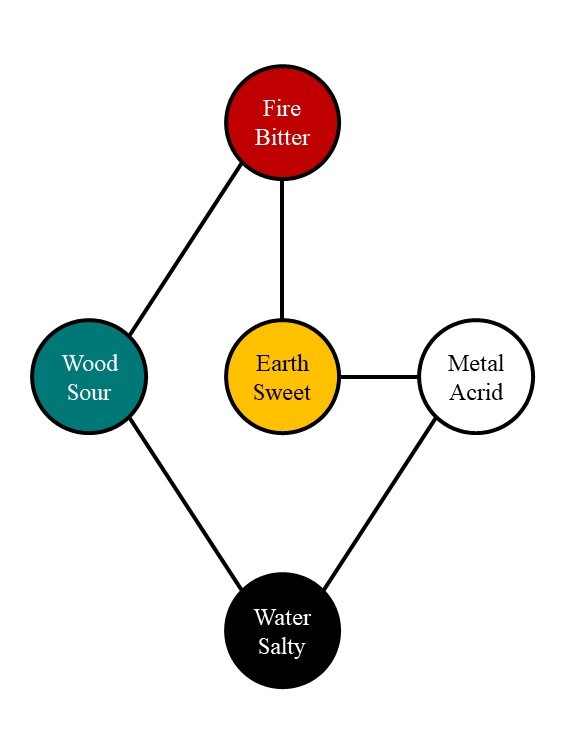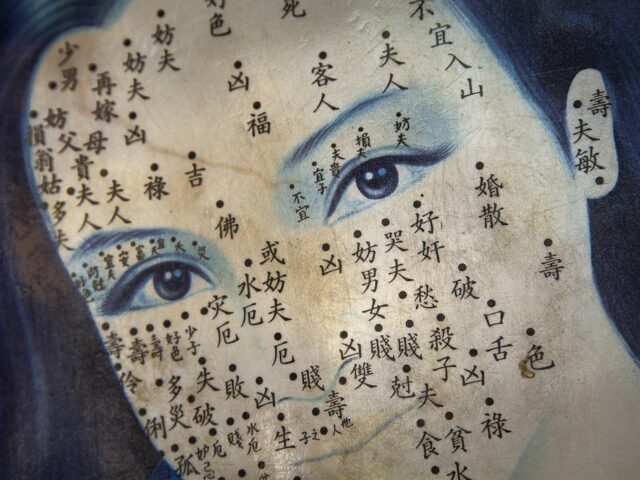Food can both positively and negatively affect our health. ‘Shi Zhi’ or Chinese Food Therapy is the idea that food is medicine and can treat illness, just like the understanding that in Feng Shui the environment can affect health for the better or worse and be used as a remedy. Like Feng Shui, Food Therapy is based on an understanding of Yin Yang and the Five Elements.
Yin and Yang in Food Therapy is temperature, but not in the sense of chilled or heated, it is the ‘nature’ of a food (Chillies, even when frozen, are still hot; and Green Tea, even when we boil it, is still cooling).
As a general rule most fruits, green vegetables and legumes are cooling, mushrooms more neutral as are grains, and root vegetables and meats warming. In Feng Shui all dwellings and sites can be classified by Yin and Yang, in Chinese Medicine too all illnesses can be classified as stemming from Yin – Cold or Yang – Heat. Very simply put, cool and cold foods lower temperature and warm and hot foods increase temperature to adjust physiology.

SPONSORED
The Five Elements correspond with various aspects of the Luopan Compass in Feng shui. In Food Therapy however their correspondence is in the Five Flavours – Sour, Bitter, Sweet, Pungent and Salty. All foods can be classified as one or a combination of these flavours. Each of the flavours corresponds with one of the Five Elements, and through that organs, structures and functions within the body.

The Elements
The Wood Element in Feng Shui is the Eastern direction, Spring, the colour blue-green, Jupiter and the number 8. In the body it is the Liver, the eyes, sinews and anger. Its flavour is Sour.
The Fire Element is the Southern direction, Summer, the colour red, Mars and the number 7. In the body it is the Heart, the vessels, blood and joy. Its flavour is Bitter.
The Earth Element is the Central direction, Late Summer or the change of seasons, the colour yellow, Saturn and the number 7. In the body it is the Spleen & Stomach, the mouth, flesh and worry. Its flavour is Sweet.
The Metal Element is the Western direction, Autumn, the colour white, Venus and the number 9. In the body it is the Lungs, the nose, skin and sadness. Its flavour is Pungent or Acrid.
The Water Element is the Northern direction, Winter, the colour black, Mercury and the number 6. In the body it is the Kidney, the ears, bones and fear. Its flavour is Salty.
Some of the connections are obvious, some not so much. Knowing how to diagnose them is the realm of the Chinese Medicine practitioner, but with a little understanding an individual can start to see the patterns and begin to match foods to their health.
The earliest Acupuncture text – ‘The Yellow Emperor’s Inner Classic’ contains a wealth of information on foods including listing foods by their flavours as can be seen in the table below.
Sweet | Sour | Bitter | Salty | Pungent |
Rice Millet | Sesame | Wheat Barley Oats | Beans | Sorghum Hemp |
Beef Eggs | Liver | Lamb Hearts | Pork Kidneys | Chicken |
Dates Grapes | Plum Raspberry | Apricot Almonds | Chestnuts | Peach Tangerine |
Mallows Sunflower seeds | Chives Garlic | Shallot Bitter Greens | Bean Greens Seaweed | Spring Onion Onion |
Malt Honey Licorice |
| Vinegar | Salt | Mustard Cinnamon Ginger |
The Yellow Emperor also talked about what types of foods to eat. He said 五穀為養,五果為助,五畜為益,五菜為充 “The Five grains for nourishment, the Five fruits for assistance, the Five meats for enriching, and the Five vegetables for filling.” The number five relates to the Five Elements and the Five Flavours mentioned above. But let’s talk a little more about each of these categories:
- Firstly, grains to nourish. Like any good building they are the foundation and should make up the bulk of dietary intake. Grains have been the basis of every diet in the history of humankind (the only exception being the Inuit), until now. Now we think we know better – grains are evil and make people overweight. Here’s a little gem – grains don’t make people fat, people make people fat. Gluttony and weight problems are a condition of the modern age, they didn’t exist in the past and still don’t in many traditional cultures. Our bodies have been conditioned for thousands of years to exist on grains, the ‘no-carbohydrate diets’ are a fad and force the body into unnatural physiological states. Just eat good whole grains and exercise a little more.
- Next, there is fruits to assist. As we all know they contain many beneficial nutrients and they should be included seasonally into our meals.
- Then, there’s meat to enrich. Chinese Medicine does not advocate a vegetarian or vegan diet, because it is based on good health. Whilst Buddhists are vegetarian (and this is where the confusion comes in) they do it to alleviate suffering, not for physiological reasons. If you choose not to eat meat to for reasons of animal cruelty good for you! but if you want to be healthy eat a little meat. In recovery from illness it is considered the most important foodstuff.
- And finally, vegetables to fulfil. Vegetables are essential to round out the diet, again like fruits they contain nutrients vital to the body. They are on the whole ‘clearing’ though, which means if you only eat vegetables its like being on constant detox and drains the body after a while.
Herbal Medicine in China owes its lineage to Shen Nong ‘The Divine Farmer’ (also known as Yandi ‘the Fire Emperor’ – food is all about cooking and fire!) and from this tradition came one of the first clinical manuals written on the practice of Chinese Medicine, called ‘The Treatise on Cold Damage’. It talks a lot about what not to eat. The author Zhang Zhong Jing gives great lists of foods that should be prohibited in illness. Nobody is in a perfect state of health so while you don’t need to entirely avoid these, you may want to consider minimising or reducing –
- 生冷 Shenleng ‘Raw or Cold food’ – especially in colder weather. Our stomach likes things at body temperature and cooking foods makes them easier to digest. Raw food might contain more nutrients but if digestion isn’t optimal they will be wasted.
- 粘 Nian ‘Sticky or Glutinous foods’ – a good modern interpretation of this is gluten. We could all do with less of it in our lives.
- 滑 Hua ‘Slimy foods’ – think oily and greasy and then think, no!
- 肉 Rou ‘Meat’ – some is good, but not too much. It shouldn’t be the majority of any meal
- 麵 Mian ‘Flour’ – even 2000 years ago they knew that too much of it was not good, especially today with modern GMO wheat and processed flour, ancient grains are king.
- 五辛 Wu xin ‘Five pungent’ – there are varied lists, usually chives, garlic, scallion/spring onion, coriander, asafoetida. These are vegetables already listed as ‘fulfilling’ and ‘good’ above, but they are overly fragrant. Any and foods like this should minimal, just a little for flavour.
- 酒 Jiu ‘Alcohol’ – again a little can be good it warms the blood but too much is certainly not better.
- 酪 Luo ‘Dairy’ – we are all lactose intolerant to some degree, some more so than others. It can also mean some types of ‘Sweets and Desserts’ – sugar isn’t bad in itself, but processed and in excess is the problem.
- 臭惡等物 Chou E Deng Wu ‘Stinky and Disgusting Things’ – spoiled foods, we might not think this is as much of an issue today with food so available but how many people reheat days later or don’t refrigerate properly and risk food poisoning on a daily basis without even realising?
Anyone who’s ever tried to Feng Shui their own home after reading a few articles online knows the difficulties and dangers of ‘Asking Google’ and diet is no different. Self diagnosis is never a good thing, if you are ill and unsure of what to eat please see your friendly Chinese Doctor for further advice. If you are generally healthy and just looking for some assistance in maintaining wellbeing and preventing disease, then I hope you found some food for thought…![]()
SPONSORED






